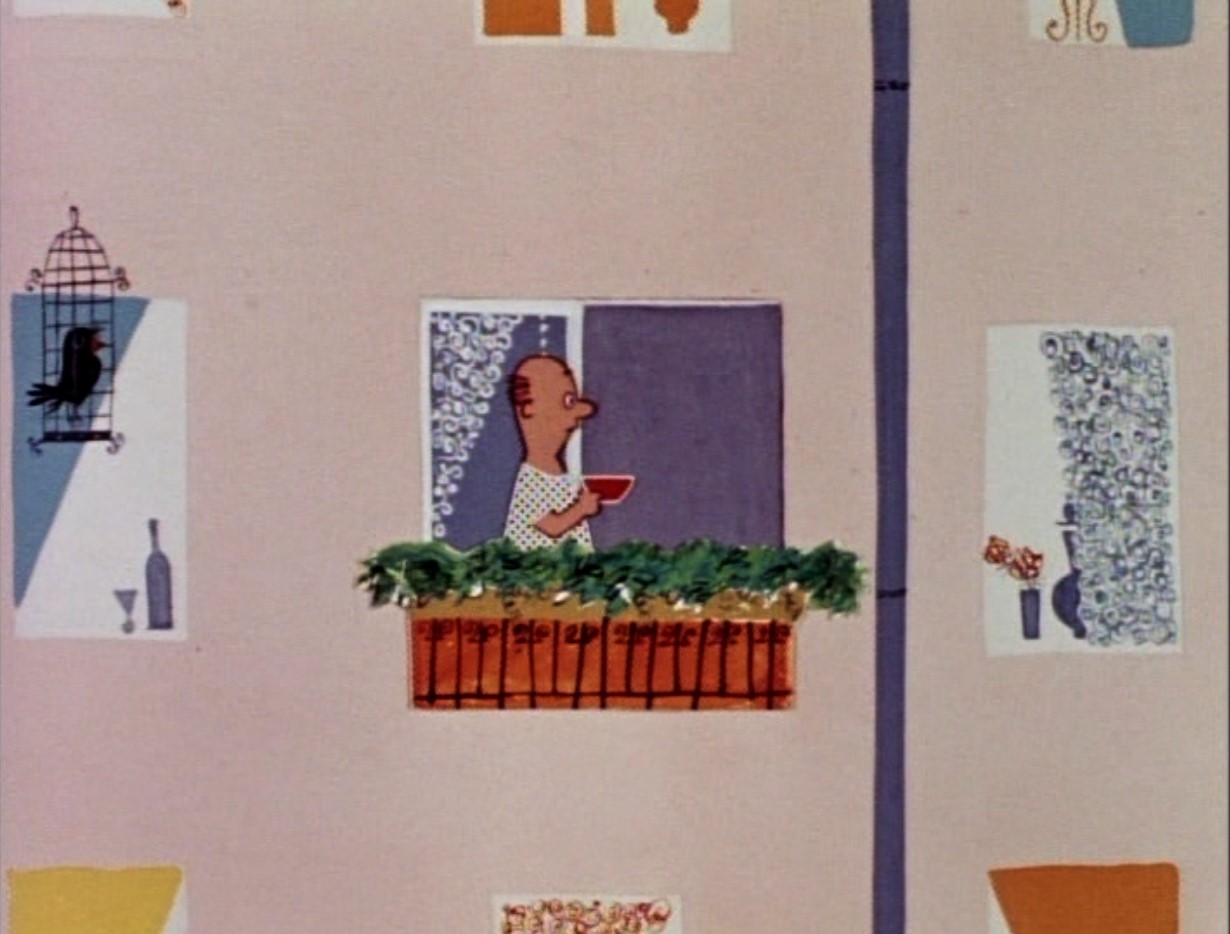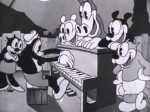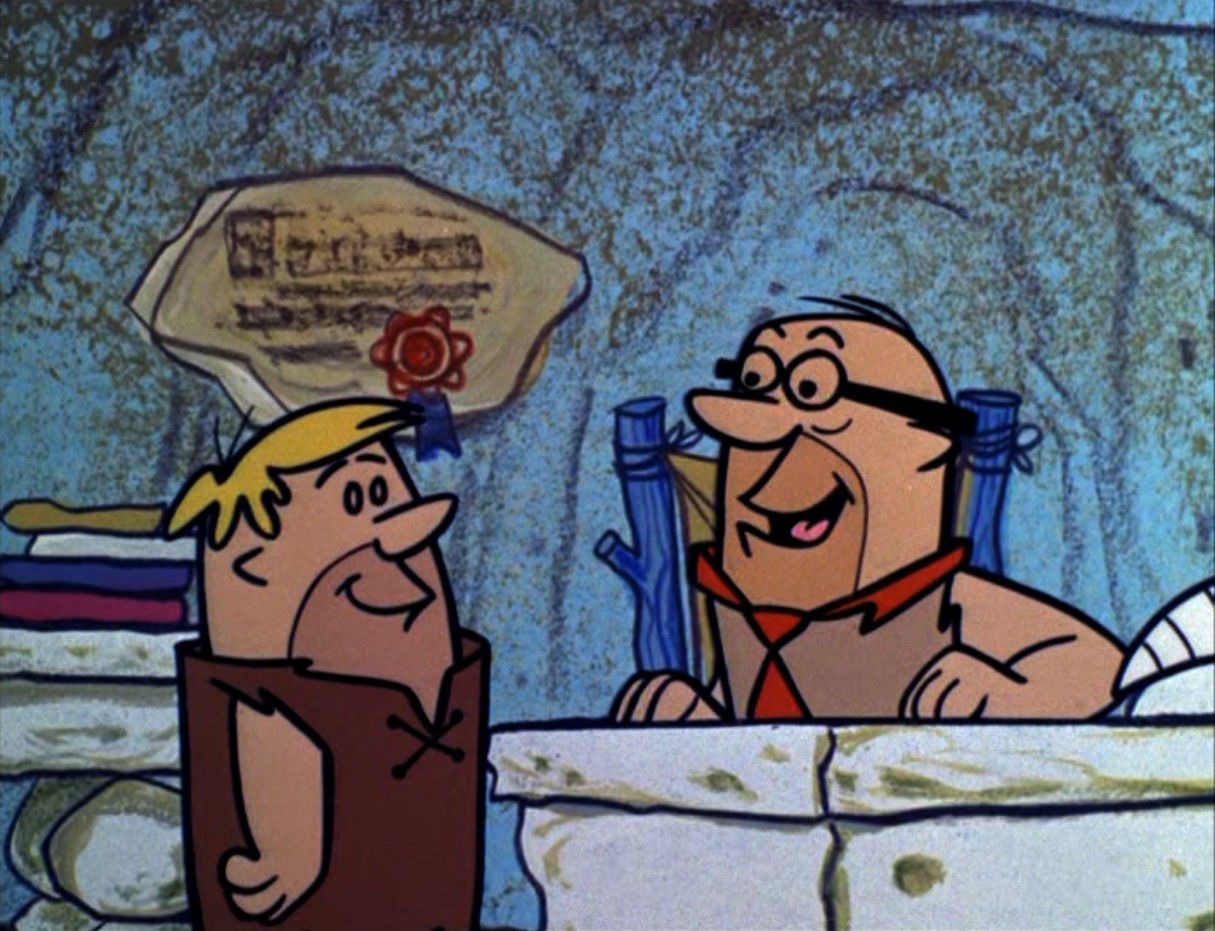You are currently browsing the tag archive for the ‘neighbors’ tag.
Director: Fyodor Khitruk
Release date: 1962
Rating: ★★★★
Review:

‘Story of One Crime’ was the first film directed by acclaimed film maker Fyodor Khitruk (1917-2012). Khitruk was one of the best comic talents in the Soviet era, as is already visible in this delightful early film.
The short starts with a man sneaking upon two talking ladies and hitting them with a large pan. At that point the narrator interrupts and takes us viewers 24 hours back. The rest of the film is told wordlessly, and shows the criminal, comrade Manin, to be a nice, gentle and hard working man. We watch him going to work, and working at the office.
All seems well, but as soon as he returns to his home, in an apartment block, the problems start. When he wants to rest on his balcony, he’s disturbed by ridiculously loud domino players playing in the courtyard. When he returns inside to watch some television, a neighbor turns on some loud jazz music, and later, when he tries to sleep, more neighbors deprive him of a good night’s rest in various ways. The film ends with a message to the viewers themselves, no doubt, more often than not living in such noisy apartments themselves.
Khitruk tells his tale with an understated sense of humor, and a relaxed, but effective sense of timing. The animation is limited, and far from fluent, but as Khitruk knows how to pose, very effective. The designs by Sergei A. Alimov, too, are a delight: the film is a rare example of Soviet cartoon modern design, and both characters and backgrounds are gorgeous throughout the film. They are partly made by snippets from magazines, and especially the neighbor’s gargantuan stereo installation is a great example of good cut and paste work.
With ‘Story of One Crime’ Khitruk took Soviet animation away from the classic fairy tale worlds of the 1950s into the modern age. The film contains some criticism on Soviet society, which is depicted as less than ideal, but the film was an enormous success, nonetheless.
With this short Khitruk immediately became one of the Soviet Union’s most important animation film makers, as he would prove, e.g. by delivering the world his delightful ‘Vinnie Puch’ (Winnie the Pooh) films of 1969-1972.
Watch ‘Story of One Crime” yourself and tell me what you think:
‘Story of one Crime’ is available on the DVD ‘Masters of Russian Animation Volume 1’
Director: Raymie Muzquiz
Airing Date: June 22, 1996
Stars: Duckman
Rating: ★
Review:

The decay of the third Duckman season continues with ‘The Longest Weekend’ in which Duckman’s street goes at war with the neighboring Dutch Elm Street.
The episode is as talkative as it is pointless, and even the numerous war film references fall flat. At this point the only attractions left are Klasky-Csupo’s idiosyncratic character designs and background art, which both remain interesting throughout.
Watch ‘The Longest Weekend’ yourself and tell me what you think:
This is Duckman episode no. 40
To the previous Duckman episode: Exile in Guyville
To the next Duckman episode: The Amazing Colossal Duckman
‘The Longest Weekend’ is available on the DVD-box ‘Duckman – The Complete Series’
Director: Mark Baker
Release Date: May 1993
Rating: ★★★★★
 After ‘The Hill Farm‘ (1989) Mark Baker returns with another strong parable on the human condition. If ‘The Hill Farm’ explored man’s relation to nature, ‘The Village’ is concerned with man’s internal relationships.
After ‘The Hill Farm‘ (1989) Mark Baker returns with another strong parable on the human condition. If ‘The Hill Farm’ explored man’s relation to nature, ‘The Village’ is concerned with man’s internal relationships.
The village of the title is a circular isolated village with all houses facing the same square. The neighbors seem godly souls, but they are all hypocrites spying on each other. Everything has to be done in secret: a cleaning lady secretly steals apples, the vicar secretly sips wine, and a stingy, bearded guy secretly plays with his money.
In this narrow-minded and stifling community a married woman falls in love with a bachelor with glasses, but they have to flee into the surrounding woods to escape the eternal gaze of their neighbors. Meanwhile the woman’s husband kills the miser, and steals his money, but it’s the bespectacled lover who gets the blame.
The village gladly builds a gallows out of the unjustly accused’s very own trees, but the lover manages to escape, accidentally killing the vile husband in the process. In the morning the omnipresent ants, which form a rather morbid running gag during the whole film, have eaten the corpse dry, and the villagers think it’s the body of the escaped convict. They break down the gallows in deep disappointment, while the two lovers flee from the village into the world.
‘The Village’ is told without words, only using unintelligible dialogue. Baker’s simple and quasi-naive style is used to a great effect, and adds to the story’s timeless value. Moreover, Baker’s timing is excellent, mixing the painful with comedy, especially when using the ants, injecting some black humor into the disturbing tale.
Watch ‘The Village’ yourself and tell me what you think:
‘The Village’ is available on the The Animation Show of Shows DVD Box Set 7
Director: Émile Cohl
Release Date: 1909
Rating: ★★★½
Review:
 ‘Les locataires d’à-côté’ is a short comic film about an old couple who decide to drill a hole in the wall to spy on their younger neighbors.
‘Les locataires d’à-côté’ is a short comic film about an old couple who decide to drill a hole in the wall to spy on their younger neighbors.
However, the hole is immediately discovered by the young victims, and the young man wonders how he can punish the nosy neighbors. How he does it remains utterly unclear, but as soon as one of the neighbors takes a peak to the hole, the young neighbors’ room disappears, and makes place for some animation, mostly stop-motion, but also some pen animation, in which Cohl shows some pretty grotesque images.
The best part is when he applies his famous technique of metamorphosis to paper-cut forms. This is essentially replacement animation in a form never tried before, and rarely after. In a sense, this piece of animation anticipates George Pal’s groundbreaking replacement animation of the 1930s. Moreover, throughout his film, Cohl employs the split-screen technique, an absolute novelty. These facts alone make ‘Les locataires d’à-côté’ a great example of the astonishing creativity Émile Cohl showed in his films of 1908-1911.
In the end the couple fetch the house-keeper, but all he sees is the ordinary room, and he leaves the neighbors, stating they are crazy. Indeed, they seem to become crazy, in the end, and it’s the young couple who has the last laugh.
Watch ‘Les locataires d’à-côté’ yourself and tell me what you think:
‘Les locataires d’à-côté’ is available on the DVDs ‘Émile Cohl – L’agitateur aux mille images’
Director: Ub Iwerks
Release Date: May 2, 1931
Stars: Flip the Frog, Honey
Rating: ★★★
Review:
 ‘Ragtime Romeo’ initially seems to revisit a theme that Ub Iwerks had explored before with Walt Disney in the Oswald the Lucky Rabbit film ‘Rival Romeos‘ and the Mickey Mouse short ‘The Barn Dance‘ (both 1928), when we watch both Flip and a Pete-like character ride their anthropomorphized cars to Honey’s house.
‘Ragtime Romeo’ initially seems to revisit a theme that Ub Iwerks had explored before with Walt Disney in the Oswald the Lucky Rabbit film ‘Rival Romeos‘ and the Mickey Mouse short ‘The Barn Dance‘ (both 1928), when we watch both Flip and a Pete-like character ride their anthropomorphized cars to Honey’s house.
But when Flip starts to serenade Honey, events take a different turn. Flip serenades her on a guitar, while yodeling and whistling, and on a piano, waking up all the neighbors. Surprisingly, they all respond enthusiastically, urging Flip to play more, except for one, who desperately tries to block out the noise. In the end she calls the police, which arrests the still performing Flip and Honey.
This short contains a piquant scene, in which Flip’s portrait watches Honey undressing. Later, the real Flip watches her naked silhouette through the window curtains. Iwerks’s studio would add more of these risque moments in future shorts, like ‘What a Life‘, ‘The Office Boy‘ and most notably ‘Room Runners‘ (all from 1932).
Watch ‘Ragtime Romeo’ yourself and tell me what you think:
This is Flip the Frog cartoon No. 10
To the previous Flip the Frog cartoon: Laughing Gas
To the next Flip the Frog cartoon: The New Car
‘Ragtime Romeo’ is available on the DVD ‘Cartoons That Time Forgot – The Ub Iwerks Collection Vol. 2’



